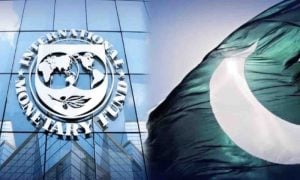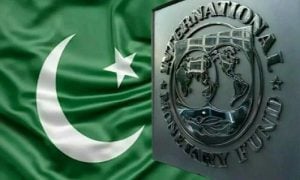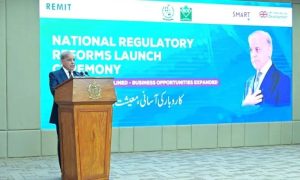KEY POINTS
- The budget offers limited relief, including a 0.5% corporate tax cut and mortgage incentives
- Finance Minister pledges stronger tax enforcement to meet a 10.9% tax-to-GDP target, citing Rs400 billion recovered
- The budget introduces new taxes—like a fuel carbon levy and pension tax
ISLAMABAD: Pakistan’s Finance Minister Muhammad Aurangzeb said on Wednesday that the federal budget for 2025-26 focuses on promoting exports and providing targeted relief.
He announced the removal of additional customs duties and reduced tariffs on 2,700 raw materials used by exporters, calling it a key step towards an export-led economy.
The Finance Minister was addressing a post-budget press conference along with Federal Board of Revenue (FBR) Chairman Rashid Mahmood Langrial and Finance Secretary Imdadullah Bosal.
Aurangzeb reiterated that yesterday’s budget aims to provide relief “as much as possible,” noting a 0.5% reduction in super tax for corporates and incentives for property buyers.
“The selling side still faces capital gains tax, but the buying side must get some space,” the Finance Minister said.
Finance Minister Aurangzeb began with tariff rationalization under the National Tariff Policy.
“People ask us if revenue will fall,” he said, “but if we are to steer this nation toward an export-led economy, we must act boldly.”
He detailed the removal of additional customs duties across four categories and a reduction in duties across 2,700 tariff lines—moves specifically targeting raw materials essential to exporters.
“These reforms are not the end,” he added. “They’re the beginning.”
Relief and responsibility
The finance minister reiterated that the budget aims to provide relief “as much as possible,” noting a 0.5% reduction in super tax for corporates and incentives for property buyers.
“The selling side still faces capital gains tax, but the buying side must get some space,” he explained.
Aurangzeb also underscored the growing importance of mortgage financing, putting it on par with taxation in shaping the country’s fiscal future.
On the hot-button issue of agriculture, the minister revealed that proposed taxes on fertilisers and pesticides—initially deemed necessary benchmarks—were rolled back after negotiations with the IMF, following direct intervention by Prime Minister Shehbaz Sharif.
“This was not just economic, but strategic,” Aurangzeb asserted. “You cannot tax the very soil that feeds the nation.”
Facing the tax gap
A major thrust of the budget revolves around raising the tax-to-GDP ratio to 10.9%.
Aurangzeb acknowledged the hard road ahead, citing Rs312 billion in new taxes out of a Rs2.2 trillion target. He was candid about Pakistan’s enforcement deficit.
“We have the laws. We have the taxes. But what we lacked was enforcement,” he admitted. “That changes this year.”
According to the minister, Rs400 billion was already recovered through improved enforcement efforts—an encouraging figure amid persistent concerns about tax evasion and compliance.
Salaries and pensions
Addressing salaries and pensions, Aurangzeb echoed the global principle of inflation-indexed pay.
“If inflation is going down, that should reflect in our wage policies,” he said, adding that expenditure control must now become a national imperative.
While acknowledging public frustration over government spending, he noted a minimal 1.9% increase in expenditures during the outgoing fiscal year—largely due to reduced subsidies and interest costs.
“We are giving, yes—but on borrowed money,” he stated. “This cannot be our forever path.”
Taxes, incentives, and trade-offs
The budget for 2025-26, unveiled under IMF scrutiny, walks a fiscal tightrope. It provides incentives to the industrial and construction sectors, moderate relief to salaried individuals, and targeted support for agriculture.
Yet, it also brings in:
- Rs2.5/litre carbon levy on fuel (to double next year),
- 5% tax on large pensions,
- 18% tax on imported solar panels, and
- Increased electricity surcharge to cover debt servicing.
Moreover, tax exemptions for tribal regions will begin phasing out, ending a long-standing fiscal buffer for those areas.


























